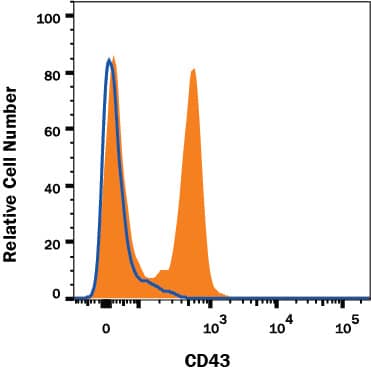Rat CD43 Antibody
R&D Systems, part of Bio-Techne | Catalog # MAB10388


Key Product Details
Species Reactivity
Applications
Label
Antibody Source
Product Specifications
Immunogen
Accession # P13838
Specificity
Clonality
Host
Isotype
Scientific Data Images for Rat CD43 Antibody
Detection of Rat CD43 by Western Blot.
Western blot shows lysates of rat lymph node, rat spleen tissue, and rat thymus tissue. PVDF membrane was probed with 0.5 µg/mL of Mouse Anti-Rat CD43 Monoclonal Antibody (Catalog # MAB10388) followed by HRP-conjugated Anti-Mouse IgG Secondary Antibody (Catalog # HAF018). A specific band was detected for CD43 at approximately 90 kDa (as indicated). This experiment was conducted under reducing conditions and using Immunoblot Buffer Group 1.Detection of CD43 in Rat Splenocytes by Flow Cytometry.
Rat splenocytes were stained with Mouse Anti-Rat CD43 Monoclonal Antibody (Catalog # MAB10388, filled histogram) or Mouse IgG1 Flow Cytometry Isotype Control (Catalog # MAB002) followed by Phycoerythrin-conjugated Anti-Mouse IgG Secondary Antibody (Catalog # F0102B). View our protocol for Staining Membrane-associated Proteins.CD43 in Rat Thymus.
CD43 was detected in immersion fixed paraffin-embedded sections of rat thymus using Mouse Anti-Rat CD43 Monoclonal Antibody (Catalog # MAB10388) at 5 µg/mL for 1 hour at room temperature followed by incubation with the Anti-Mouse IgG VisUCyte™ HRP Polymer Antibody (Catalog # VC001). Before incubation with the primary antibody, tissue was incubated with VisUBlock™ Mouse on Mouse Blocking Reagent (Catalog # VB001) and then subjected to heat-induced epitope retrieval using Antigen Retrieval Reagent-Basic (Catalog # CTS013). Tissue was stained using DAB (brown) and counterstained with hematoxylin (blue). Specific staining was localized to lymphocytes. View our protocol for IHC Staining with VisUCyte HRP Polymer Detection Reagents.Applications for Rat CD43 Antibody
CyTOF-ready
Flow Cytometry
Sample: Rat splenocytes
Immunohistochemistry
Sample: Immersion fixed paraffin-embedded sections of rat thymus incubated with VisUBlock™ Mouse on Mouse Blocking Reagent (Catalog # VB001) and then subjected to heat-induced epitope retrieval using Antigen Retrieval Reagent-Basic (Catalog # CTS013)
Western Blot
Sample: Rat lymph node, Rat spleen tissue, and Rat thymus tissue
Formulation, Preparation, and Storage
Purification
Reconstitution
Formulation
Shipping
Stability & Storage
- 12 months from date of receipt, -20 to -70 °C as supplied.
- 1 month, 2 to 8 °C under sterile conditions after reconstitution.
- 6 months, -20 to -70 °C under sterile conditions after reconstitution.
Background: CD43
CD43, also known as Leukosialin, Sialophorin, B-cell differentiation antigen LP-3 and Ly-48, is a type I transmembrane sialylated mucin that is expressed on most leukocytes and some tumor cells. Notably, the membrane expression of CD43 seems to be a characteristic of leukocytes, while cytoplasmic expression without membrane insertion occurs in endothelium and select epithelia. While CD43 restricts leukocyte adhesion and modulates T cell activation, these activities are context specific. CD43 can both induce and protect against apoptosis, and can either promote or block cell adhesion. In mouse, CD43 is synthesized as a 378 amino acid (aa) precursor that contains a 7 aa signal sequence, a 224 aa extracellular region, a 23 aa TM domain, and a 124 aa cytoplasmic tail. Rat CD43 extracellular region shares a 61% aa sequence identity with the extracellular region in mouse CD43.
Long Name
Alternate Names
Gene Symbol
UniProt
Additional CD43 Products
Product Documents for Rat CD43 Antibody
Product Specific Notices for Rat CD43 Antibody
For research use only

